Kayak and sailing fleets depart from Fort Desoto Park beach
Daybreak at Fort Desoto Park looked rather ominous for adventurous racers setting off on the 2012 WaterTribe Everglades Challenge and concurrent events. Low clouds were flying by overhead and a strong southerly wind was lashing the shore. At least it was warm, but that headwind would make departure and the first day of the trip difficult. The forecast called for a front to pass through overnight with a squall line and winds shifing around to NW and then strong out of the north the next morning.
The competitors and boats were all lined up above the high tide line. Most were engaged in last minute boat preparations, packing gear and watching the weather with some apprehension. They were looking at a tricky departure through the small surf followed by a wet slog upwind across Tampa Bay to start the race.
![]()
A stroll down the Fort Desoto Park East Beach at dawn as the WaterTribe race participants prepare to depart:

The sun rising above the Sunshine Skyway bridge and many sails going up as start time approaches.
Most of the kayaks were concentrated on the beach in this area and they left in a pack.

One of the first boats to catch my eye as we walked onto the beach was Mosquito, a custom trimaran made by a young man named Alan. (Update: his blog here) I remembered some discussion of this boat from the B and B Yacht Design forum, and a friend had told me to be on the lookout for it. Alan and his mother are doing the WaterTribe Ultimate Florida Challenge, a 1,200 mile circumnavigation of the State of Florida. The Everglades Challenge is just leg one of this larger adventure race.
WaterTribe has a number of funny rules, and they call them filters. The idea is to filter out large or complicated boats by making racers do things only a small or simple boat could do. The biggest examples are the beach launch and sections of the course where human propulsion (with masts down) is necessary, but the portage is another. The rules in years past had basically said that you have to bring along any portage equipment for the whole trip and you have to use the same boat for the whole trip. This time, they are allowing competitors to switch boats for the upstate river section of the journey, with shoreside crews transporting the boats back to the West Coast for the finish. I was wondering how they would portage Mosquito those 40 miles. The answer is: they will not.
One of the things that struck me as strange about Mosquito was the open holes in the transoms and on the tops of the amas. Amas are generally sealed. I asked Alan about them and he said they have a floor inside and underneath it is foam. The open portion is self-bailing.
A view of the wave-piercing bows on the amas of Mosquito. The boat is pretty wide. I asked Alan whether it would fit through the bridge at the first checkpoint, and he said he thought so, but was not sure. I found that answer pretty funny. He said that if necessary, they could go through what sounded like a complicated operation to demount an ama to get through, but he was trying not to think about it.
As I write this, our whole discussion has turned out to be moot. It is now Monday the 5th, and the latest SPOT signal WaterTribe Tracking Map shows that Mosquito is offshore of Sarasota and moving south. Meanwhile, over on the WaterTribe Discussion Forum, the Chief has announced that competitors can just sail on by Checkpoint 1 without stopping to check in. They will not have to demount an ama.

As I looked at the otherwise fine construction of this little boat, I could not believe it when I saw what appeared to be a bit of redneck engineering, and not very well done at that. Anyone knows you have to wrap the duct tape tighter to stop leaks! And what is this boat doing using duct tape on leaks in the first place?
I learned the answer a little while later, when I saw Alan putting duct tape around another waterstay base. He was making a cup to hold water next to the waterstay to try to determine which one was leaking. They took on some water sailing around from the boat ramp and also discovered several minor rigging problems. He told me that even with a poorly trimmed jib and a reversed ratchet block on the mainsheet, they were able to achieve a top speed of 16 knots.

They were trying to get some things done on the boat in a hurry, even though by this time the decision had been made to delay departure until the weather improved. One problem was the nonstop stream of people who wanted to ask questions about the boat. I admit to later becoming part of that problem myself. Alan acted like he had plenty of time to answer anyone's stupid question (I actually watched one guy peering around a daggerboard to ask him if it had one). My contribution was to ask about those poles next to the daggerboards. He said they were needed to carry the up/downhaul line, then launched into an explanation of how the boards were controlled by a single loop of line that ran all around the boat. I did not understand much of his routing explanation, but I liked the bottom line: pull one way, boards down, pull the other way, boards up. Cool!
I had to include this picture of the tiller. It's a work of art all its own, as is the rudder. That hatch lid has a carbon fiber reinforced rim and weighed only an ounce or so (I couldn't resist picking it up).

One of the boats I had come to the 2011 Everglades Challenge start to see was the trimaran Sizzor created by sail maker Randy Smyth (WaterTribe name "Sew Sew"). I arrived just in time to see him depart. This time I got a closer look at the scissor like mechanism that allows him to swing one ama forward and the other back on the big beam anchored in the center of the boat. It is a neat solution to the low, narrow bridge filter, but looks a bit fragile to me. As I write on 3/5/12 at 5 pm, I'm checking the WaterTribe tracking site periodically, and the first boat has finished. It is a Tornado catamaran. The next one is not too far behind, approaching the third checkpoint down in Flamingo. That boat is a Hobie 18. Sew Sew seems to be having some trouble reaching the second checkpoint and a lot of boats are right on his heels. Even the lowly Puddle Duck Racer is charging down Pine Island Sound less than 60 miles behind. I guess something on Sizzor broke.
There were some really interesting non-homebuilt choices for the competition this year. An A-Cat? There is almost no boat there! It will be like a high speed swim down the Gulf Coast, I suppose. This was far from the craziest boat we saw on the beach.

I started laughing when I saw that one competitor had chosen a Sunfish for the race. I just could not see how it could possibly carry the gear needed for the Everglades Challenge. I later learned in a forum discussion that the sailor is very experienced and is only doing the WaterTribe FL Ultra Marathon, which is the first 67 mile leg of the EC. That is not all that crazy, especially if they had any other weather forecast. The hard part will be crossing Tampa Bay into a strong headwind, but it can be done and the rest will not be so hard for a Sunfish.
He has several layers of charts taped across the stern of the boat. The plan apparently is to peel off layers of his "chart table" as he progresses. Pretty clever!
Another interesting off-the-shelf choice was this Precision 14. They are no longer made, but like the current Precision 15 model, this is a family daysailer and a good training boat. It is not a high performance machine and would really have a long, wet struggle trying to beat across Tampa Bay. Recognizing its limitations, these folks are putting it back on the trailer after aborting the race prior to the start. The rules say you must launch by yourself, but at least you can get a pack to help if you must go through the disappointment of preparing for a race and then aborting at the start.

This is more typical of the kind of thing I expect to see on the beach for the Everglades Challenge. I do not know what it is, but while it looks home-built, it definitely makes use of some stock parts. Those appear to be Hobie Adventure Island masts. Update: according to a caption and looking at this picture I found online, those are masts from a Tandem and Solo Adventure Island, and the boat also has a Mirage Drives. It's a Super Island!
This expedition canoe type craft carried a crew of two. The sail looks a bit small for the load, but is reefed down. There is another section that goes between the two battens that are right next to each other.

The thing I like best about this event is that it draws a swarm of little boats that make me ask, "What's that?" This guy was busy and I did not ask him, but his little red boat caught my eye and made me wonder. It looks like one that just might be able to make it!
These people brought this E Scow all the way from upstate New York to compete in the Everglades Challenge. I heard that they had to drop out on the first day after discovering or creating some new leaks trying to beat across the nasty chop in Tampa Bay. I think that if they had waited for a tailwind, they might have had a shot. It's still a pretty unusual choice for the race, but that is what is neat about this race. Everyone has different ideas about how to deal with all the filters put in place by the rules.

I think this large outrigger canoe was paddled by a crew of five people, but I'm not quite sure. It won my award for "most interesting lighting setup." A Mag Lite flashlight lashed atop some kind of bracket that also holds red and green flashlights. They must have a hoard of batteries someplace aboard.
Perhaps because of the upturned ends on the hull and ama and the curves of the akas, this one reminded me of a plastic version of some kind of Polynesian war canoe. I think it had a crew of six. With their long waterlines and the power of multi-person teams, these two should be able to do pretty well in the Everglades Challenge. Sort of makes me wonder why I did not see any last year. Maybe it is not as good an idea as it seems. I guess they are finding out!

Ranking high in the "craziest entry in a crazy race" category was a familiar face for me: Scott, the winner of the 2011 Sun Cat National Championship. Impressed with the performance of Puddle Duck Racers in events like the Texas 200 and disappointed with his failure to complete last year's Everglades Challenge in the catboat Lil Gem, he built a custom Puddle Duck Racer designed just for the Everglades Challenge. One thing it does not do very well is point upwind in a fierce chop, and Scott was nervously watching the weather and trying to decide whether or not to attempt departure. I gave him my cellphone number in case he needed local logistical help with a rescue.
Update Tuesday 3/6 around noon: Scott capsized the PDR and lost some equipment. He is safe on the beach, but is withdrawing from the race.
I thought he might be the craziest until I saw this little blue pram type vessel. Another whatsit, it is completely open. Waves are almost guaranteed to come aboard crossing Tampa Bay, and if he capsizes, righting a swamped boat can be difficult. At least Scott's Puddle Duck has buoyancy compartments along each side. Joining these two in the micro-sailboat category was a previous participant sailing a little boat called Sand Flea, but the only picture I got was blurry. In the background is a Hobie Getaway, a rotomolded plastic family beach cruiser. Another interesting choice for the race.

There are a lot of different kayak sailing rigs, many with inflatable amas, participating in the Everglades Challenge, but this one caught my eye. The aka bar is fairly long and the mast is quite tall for a kayak. Also, it is a roller furling sail and the leeboards and rudder look a bit more serious than some of the other sailing kayak rigs. All of those things tell me it is probably faster as a sailboat than most of the rest. The paddle is one of the old Eskimo kind, just a piece of wood with small blades at each end. Those paddles do not look like much compared to modern ones with curved blades and carbon fiber shafts, but in the right hands they are very powerful. I have been on the receiving end of a couple of lessons in that fact, so I know firsthand.
Another sailing/paddling boat that was a real eye-catcher was this wooden beauty. I do not think I could build something this nice and then set it down on a salty, sandy beach. It looks too much like fine furniture for that treatment! The sailing rig is small and the boat is pretty beamy in the stern, but it still looks like it would be an exciting ride in the 15-20 knot headwinds. That enormous leeboard should help! I like a man who believes in some back support in a small boat, but this guy has gone a bit further than even I would go. That seat is starting to get beyond back support and into headrest territory and the sheepskin cover is a bit over the top. I bet it is comfy, though!

Next to that boat was another entry in the "sailing fine furniture" racing fleet. It looks a bit like a Skerry from Chesapeake Light Craft, but the transom is wrong. I'm not sure what it is, but it is another boat I would not want to set on a salty, sandy beach. I'm also not sure foam noodles are classy enough for this boat as a floatation method, but I have never been a great judge of classy.
There were several Core Sound boats in this year's race, including a gorgeous one with a green hull and a custom dodger, but I thought this Core Sound 17 named Bandaloop was the best looking of the bunch. The Core Sound designs from B and B Yachts have done well in several Everglades Challenges in the past, and this boat's big sister, the Everglades Challenge 22, holds the Class IV record for the course. I have it in my head to build one and do the race, if I can ever find the time and money to do so.

I understand that the homebuilt catamaran Slider aborted the race prior to starting. That's too bad, but understandable. It does not appear to be a good boat with which to beat across Tampa Bay in a strong breeze and I have to wonder just how they paddle this thing. Not very well is my guess. I'm not sure it could get out to deep enough water to get going if they tried to start.
Still, that is the kind of boat I come to the Everglades Challenge to see. I'm usually not a fan of asymmetry, especially in boats, but the idea of having one ama open with a Bimini top for those nice days and one with a little pilothouse enclosure for nasty days seems like a practical idea, especially up in the Florida Panhandle where this boat lives. They have year-round sailing up there like we do down in Punta Gorda, but not exactly like we do. It can get darn cold up there. OK, so the house is a little boxy and that daggerboard is at a funny angle, but it is all very practical. To those who can't stand the funny looks I would say, "Look in some other direction."
This one is really the kind of boat that I come to this event to see. It's like he went down the list of possible weird sailboat design choices, got to the bottom, and checked "all of the above." Well, it's not a proa, but that might be too weird to even be on the list. There are a lot of strange things about it, but all seem to me to make it uniquely capable in this race.
It's a lug rig, which solves the problem of how to split the rig of a small boat without the clutter that results from any flavor of ketch rig. Splitting the rig allows a larger small boat, since rig size is a major factor in the ability to step the rig to get under the low bridge. It also has very low freeboard for its size, especially for a boat that is obviously not intended as a racer. Cruisers are higher, but that means more boat, which means it is harder to shove it off a beach or row it. Speaking of rowing, I can not see where they go, but the name Oaracle suggests it is intended to be a pretty decent rowing boat, and it looks like it is to me. That low cabin would make many cruisers say, "Why bother?" but I guess it was pretty cozy when the cold front blew through. The ability to let one crew member rest while the other presses on is important in this race, and many of the racers were likely trying to sleep while cold and wet.
Best of all, when this boat left the beach it took off at surprising speed sailing much closer to the wind than I expected. I do not think it was going to be passing the Lightning upwind, but the performance seemed pretty respectable to me. It is leaving at the end of the video below.

Some video of the 2012 Everglades Challenge start at Fort Desoto Park Beach:

And away it goes! The breaking waves just in front of the Norseboat's sail indicate a small sand bar out there, only about knee deep or so. That funny looking lugger sailed right across it going upwind nicely. I do not know what kind of board it has down, but it can not be down very far and it is working well. I expected them to row some distance off the beach, but they just shoved off and started sailing upwind.
One of the later departures shown in the video below was this catamaran called Teak E Torch. I read somewhere that this boat is equipped with Hobie Mirage Drives in each hull. It is about time someone did this! The Mirage Drives in our Hobie Adventure Islands are an excellent auxiliary propulsion source when the wind is not blowing or we have to go straight upwind. I can pedal significantly faster than I can paddle in my AI, and with much less effort.
A pair of stock Mirage Drives with Turbo Fins will probably drive Teak E Torch pretty well. They could make Mirage Drive well plugs with built-in daggerboards for sailing upwind when the drives are not needed, and flush plugs for sailing downwind. I also think the idea could be applied to a lot of other small sailboats if there were a Mirage Drive that was operated from either side instead of from a seat behind the drive. Many little sailboats carry 2 hp outboards because paddling is ineffective and oars that would work are too long and cumbersome to store. They just need a Mirage Drive like device that slips in the daggerboard slot to harness the power of the sailors' legs.

The Core Sound 17 Bandaloop looked a bit bow heavy as WaterTriber Mister Moon rowed out over the small breakers on the sand bar. The bow of the boat is no doubt stuffed with provisions and gear. These boats can actually stow those oars, but I note that there is still an outboard bracket hanging on the back. I wonder if it is a candidate for a modified Mirage Drive or two?
Once past the bar, Bandaloop was a pretty sight sailing away into Tampa Bay in the morning light. I'm not sure my camera or photography skills do her justice.

I saw this beautifully maintained Sea Pearl 21 named Moon Shadow at last year's race and it was back again, but this time with a solo sailor, WaterTriber Jarhead. He struggled mightily to get the boat rolling down the beach on inflatable rollers then had a bit of a time getting her out over the sandbar and sailing. Once he got in and started sailing, he still had his rudder up and people on the beach were yelling for him to put it down, but he was steering pretty well with the sails and I think he might have left it up on purpose just to get a bit further from the sand bar.
Unfortunately, Jarhead's race came to an end later in the day off Anna Maria Island, when a large powerboat wake and a sudden gust conspired to nearly capsize him and shoved the boat into a channel marker, ripping his new sail.
This guy had a bit of a struggle rowing upwind across the small breakers on the sand bar, then sailed off into the sunrise like it was a good idea or something. He is really asking to have a few of those "Oh God thy sea is so great and my boat is so small" moments. Anyone this crazy probably has a whole necklace full of the shark and alligator teeth that the WaterTribe hands out to those who finish the Everglades Challenge. You have to venture through part of the Everglades National Park Wilderness Waterway called "The Nightmare" to get one of the gator teeth, apparently. I think I may skip that part if I get to do the race. Too similar to my back yard.

This Lightning is amusingly named Hare On Fire and it looks like it is loaded with enough stuff in dry bags to soon be a very wet wabbit. These guys were here last year and know what they need to bring.
Once it got over the bar and into enough water, I expected to see the Lightning take off pointing high upwind, but they sailed along a bit lazily with the jib barely trimmed for a little while after they left. I guess they were still sorting and storing stuff and blasting along at full speed upwind in the wind and chop they faced would require concentration.

One of the last boats to go in the water was this Windrider 17 trimaran. It looks a bit ungainly on the sloping beach due to the keel shape, but I hear these are fun to sail. It's a reasonable choice for the Everglades Challenge if they can paddle it effectively. Unfortunately, I read that this boat had to drop out after some leaks developed while pounding across Tampa Bay.
This was one of the scenes that I thought must appear odd to those just arriving at the beach last year, and it seemed the same this year. There is a sprinkling of boats scattered along the beach, most of them unmanned, and one man is tugging this little sailboat's bow back and forth, allowing the boat to creep a bit down the hill each time he manages to wiggle it back and forth. Meanwhile, several able-bodied people stand around and watch, with some taking pictures. If you do not know what is going on, it must seem kind of cruel.
As the boat fell down the gentle slope of the beach, it pushed up a small sand dune in front of itself, so the man had to kick sand out from under it before wiggling it back the other way. It reminded me of a little boat called Mullet that was launched last year by spinning down the beach. Not the most graceful entry, but hey, it worked! The video below shows part of the struggle and some of the other late departures.

Some of the late departures from Fort Desoto Beach for EC 2012:

When we were done watching the departures, I went to breakfast in St. Pete with my friend and his wife. At around 11:00 I was driving over the Sunshine Skyway bridge on my way home when I spotted what could only be an Everglades Challenge participant sailing close to the southern base of the bridge. There is a park and fishing pier there, the remains of the old bridge that was hit by a ship. I decided to pull over to see if I could get any pictures.
When I got to the end of the filled causeway at the base of the fishing pier, the boat was getting close. It also looked a bit like it might not be able to tack in these conditions. The shoreline here is composed of oyster-covered limestone rocks that they used to prevent erosion when they filled the causeway. It seemed to me that a blown tack might land this person on those rocks, probably inflatable part first. I decided to drive down to where I thought that might happen, just in case.
I got back in my truck and drove a short distance. When I got back out the boat had tacked and was making way away from the shore. I was relieved that I would not be climbing down any sharp rocks. A later look at the area NOAA chart revealed that this was probably a good strategy. It allowed him to get the largest waves of Tampa Bay over with in one long tack, then stay close enough to shore and shallow waters to avoid large waves the rest of the day. I imagine waves are real speed killers for the boats carrying those inflatable amas, so avoiding them was a good move. A short video of this encounter is below:

Everglades Challenge 2012 participant near Southern Sunshine Skyway Fishing Pier Park at 11:00 am
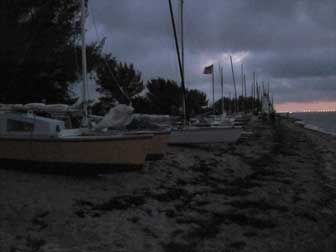
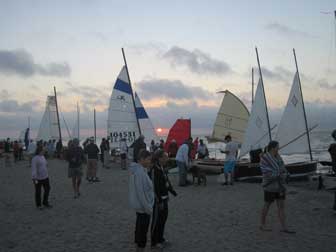
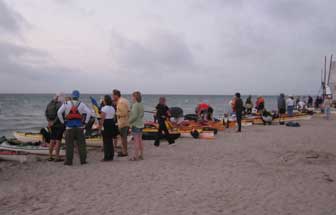
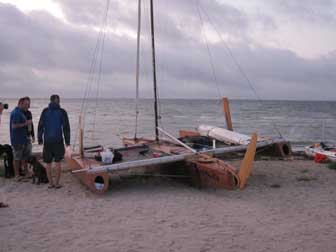
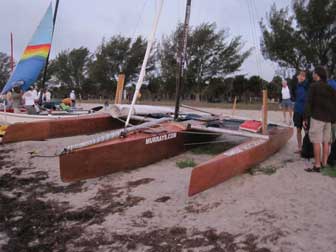
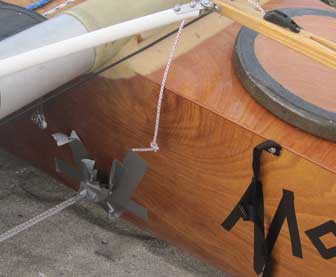
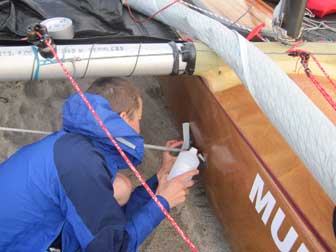
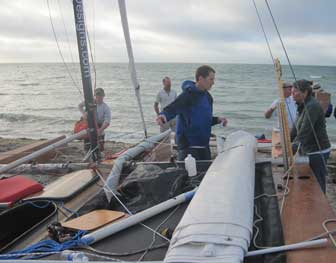
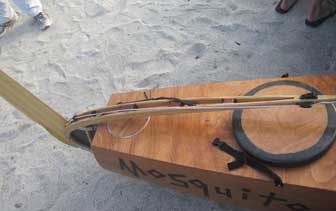
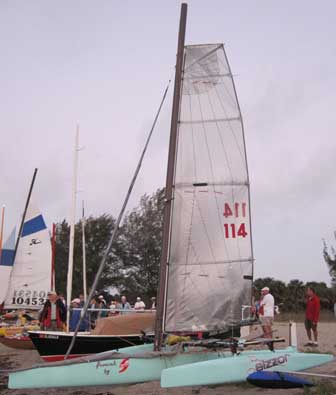
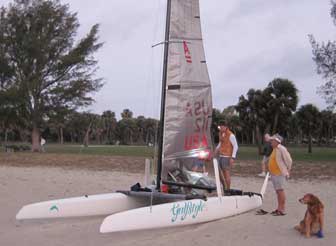
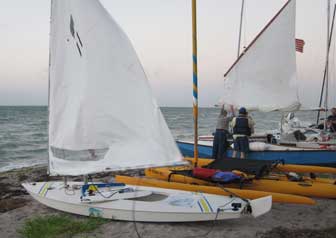
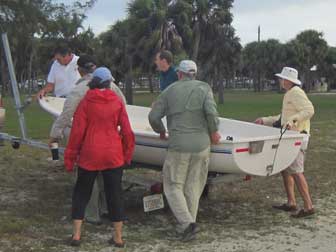
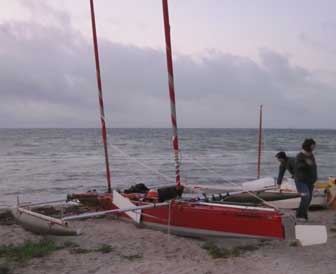
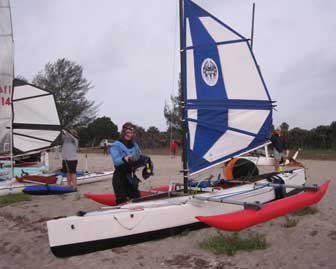
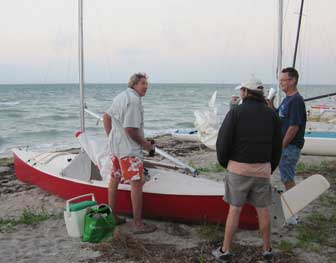
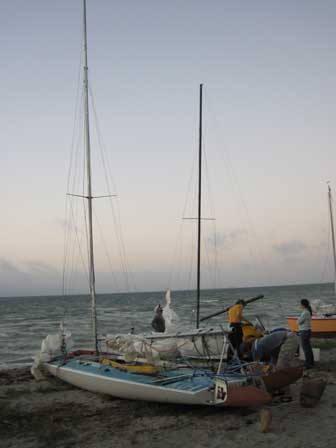
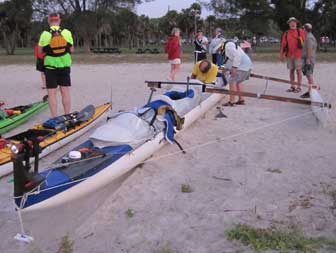
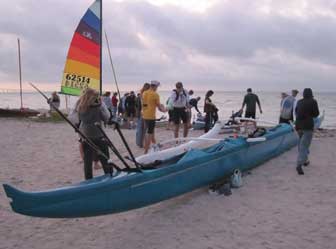
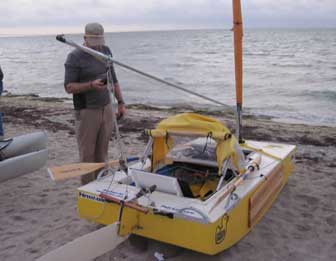
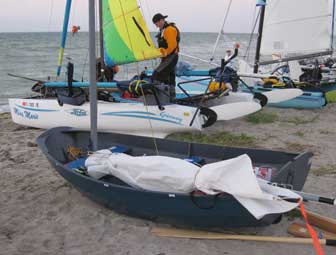
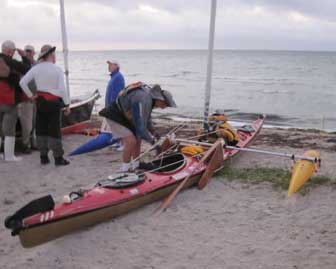
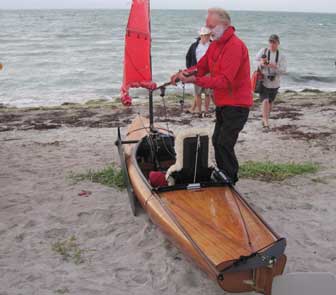
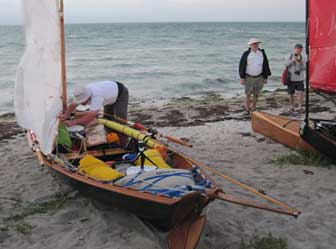
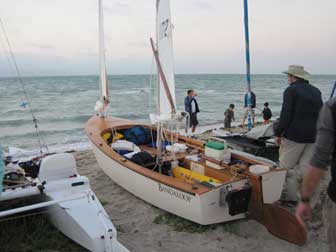
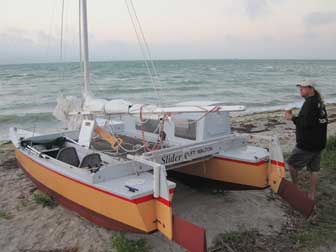
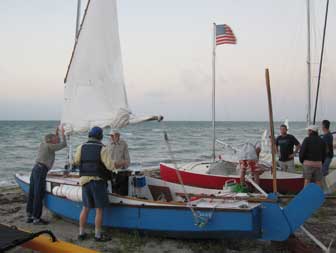
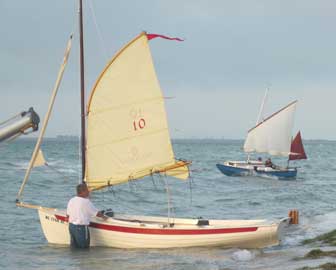
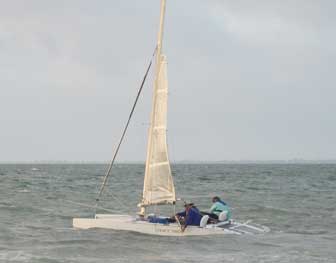
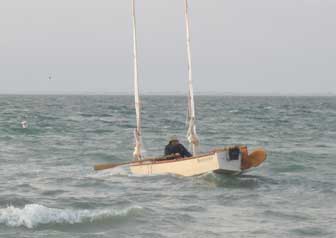
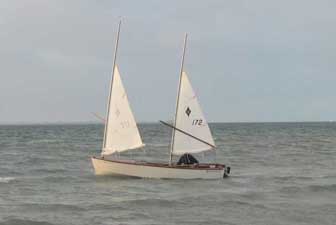
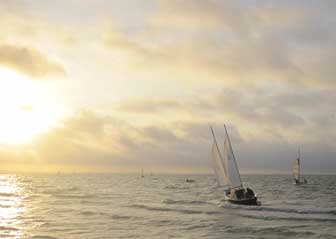
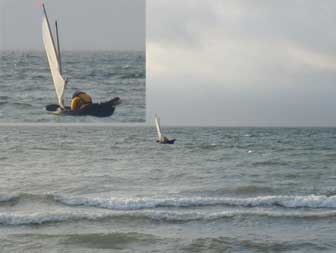
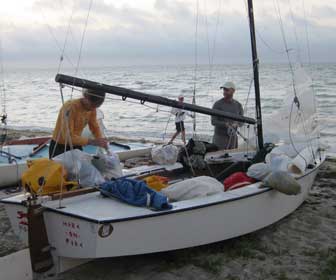
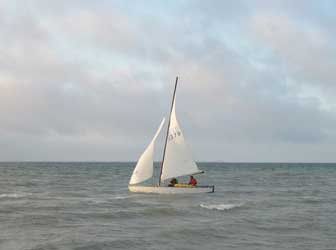
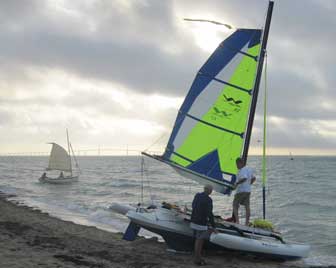
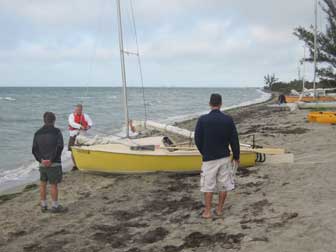
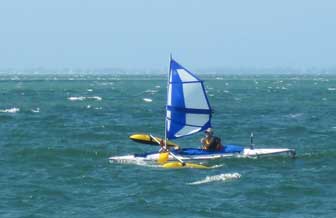
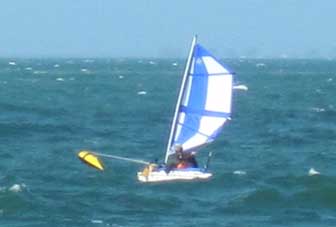
Leave a Reply
You must be logged in to post a comment.